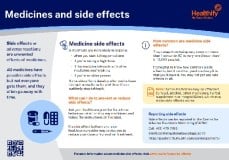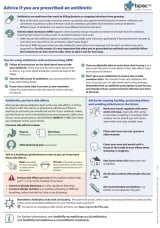Pyrazinamide
Sounds like 'pie-rah-zin-ah-mide'
Key points about pyrazinamide
- Pyrazinamide is used to treat tuberculosis (TB).
- Find out how to take pyrazinamide.

Pyrazinamide is used to treat tuberculosis (TB). TB is an infection that mostly affects your lungs, but can affect any part of your body. TB is treated by taking a combination of antibiotics for at least 6 months – pyrazinamide is just 1 of the antibiotics prescribed. Read more about TB.
In Aotearoa New Zealand pyrazinamide is available as tablets (500mg).
- The dose of pyrazinamide is different for different people, depending on your body weight.
- Always take pyrazinamide exactly as your doctor has told you.
- The pharmacy label on your medicine will tell you how much to take, how often to take it and any special instructions.
- Timing of your dose: Take your pyrazinamide tablets once a day, at about the same time each day. You can take your dose with or without food. Swallow the tablets whole with a glass of water. If you have problems swallowing the tablets, they may be halved or crushed. Ask your pharmacist for advice.
- Missed dose: If you forget to take your dose, take it as soon as you remember. But if it's nearly time for your next dose, take the next dose at the right time. Don't take extra doses to make up for a forgotten dose. If you often forget to take pyrazinamide, your tuberculosis may not be fully treated.
- Finish the course. Keep taking your tablets regularly unless your doctor tells you to stop. It's important you finish the course so the infection doesn't come back. If you stop taking the tablets before your course has finished (eg, due to possible side-effects – see below) then you must let your doctor know about it straightaway so you can be given different treatment for your TB.
Here are some things to know when you're taking pyrazinamide. Other things may be important as well, so ask your healthcare provider what you should know about.
- Pyrazinamide can interact with some medicines, herbal supplements and rongoā Māori, so check with your doctor or pharmacist before starting pyrazinamide and before starting any new products.
- Limit alcohol while you are taking pyrazinamide. Alcohol can increase your chance of side effects, eg, problems with your liver.
- Pyrazinamide makes your skin more sensitive to the sun. Protect your skin when you're in the sun – wear protective clothing and use a high factor sunscreen (SPF 30+).
- Tell your doctor if you're pregnant, planning to become pregnant, or breastfeeding.
- Tell your doctor if you have gout. Pyrazinamide may cause a gout flare-up.
Like all medicines, pyrazinamide can cause side effects, although not everyone gets them. If you're concerned about any symptoms you think might be related to your medicine, talk to your healthcare provider. The following information offers some guidance but doesn't include all possible side effects.
Common side effects
Tell your healthcare provider if these side effects bother you.
- Nausea (feeling sick), not feeling hungry or a sore tummy.
- Diarrhoea (runny poo): Tell your healthcare provider if your diarrhoea is severe, contains blood or lasts more than a few days. If you have a lot of diarrhoea or have been vomiting and you're taking the oral contraceptive pill, let your healthcare provider know.
- Feeling tired or dizzy: Be careful when driving or using tools until you know how this medicine affects you. Don’t drink alcohol.
- Pale skin.
- Joint or muscle aches or pains.
Tell your healthcare provider immediately or phone Healthline free on 0800 611 116 if these occur
- Skin rash or itching.
- Signs of problems with your blood cells such as bruising or bleeding easily, ongoing sore throat, mouth ulcers, dizziness, feeling tired, fever or chills.
- Signs of problems with your liver such as severe tummy pain, yellowing of the eyes and skin, dark urine.
Read more about medicines and side effects and reporting a reaction you think might be a side effect.
Pyrazinamide(external link) New Zealand Formulary Patient Information
Brochures
Advice if you are prescribed an antibiotic(external link) BPAC, NZ, 2024
Advice if your child is prescribed an antibiotic(external link) BPAC, NZ, 2024
Medicines and side effects(external link) Healthify He Puna Waiora, NZ, 2024
References
- Pyrazinamide(external link) New Zealand Formulary
Brochures

Advice if your child is prescribed an antibiotic
BPAC, NZ, 2024

Medicines and side effects
Healthify He Puna Waiora, NZ, 2024
Credits: Sandra Ponen, Pharmacist, Healthify He Puna Waiora. Healthify is brought to you by Health Navigator Charitable Trust.
Reviewed by: Angela Lambie, Pharmacist, Auckland
Last reviewed:






